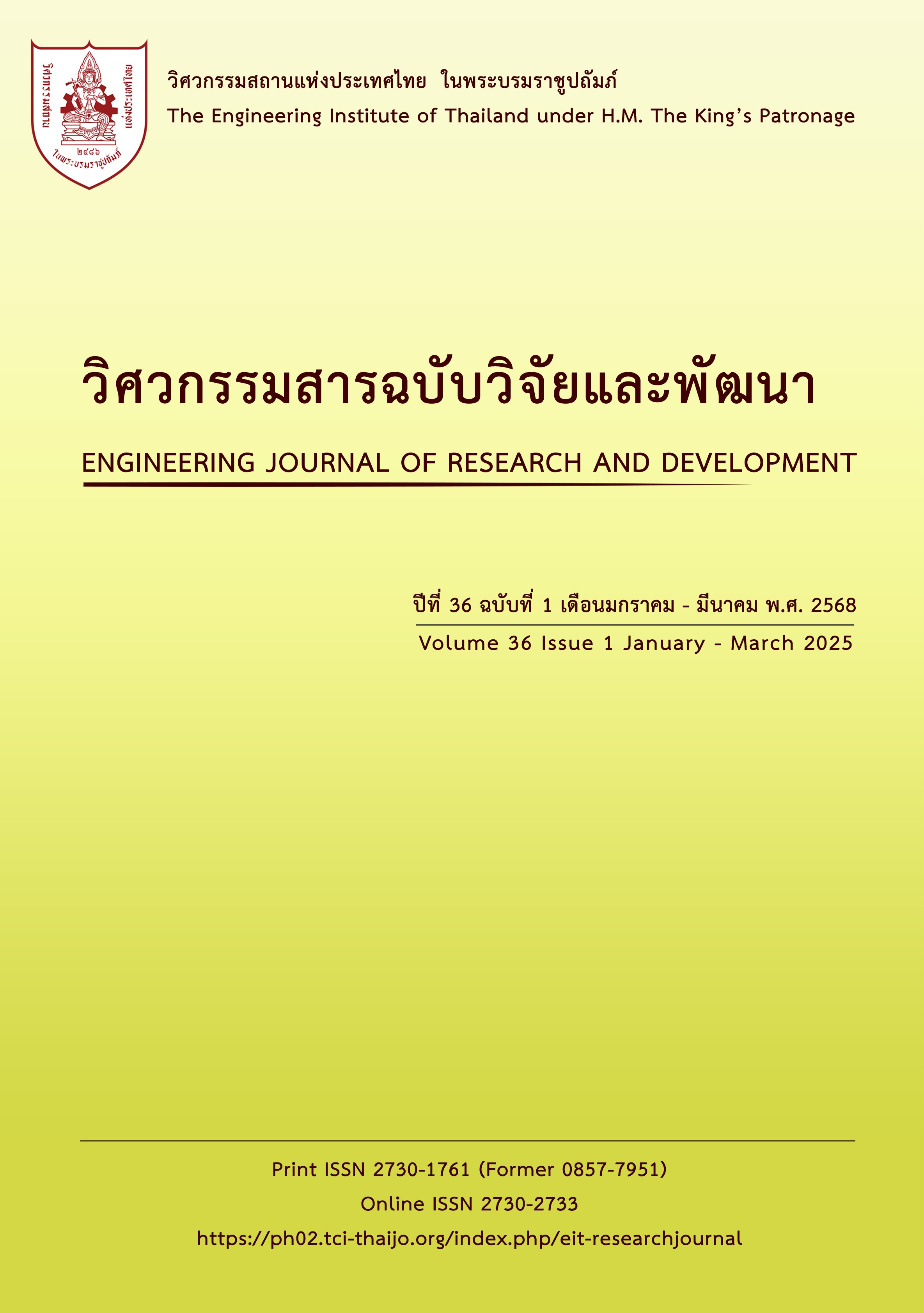การวิเคราะห์สัดส่วนของเศษพอลิโพรพิลีนสำหรับการฉีดขึ้นรูปชิ้นส่วนเทอร์โมพลาสติกของเครื่องใช้ไฟฟ้า
Main Article Content
บทคัดย่อ
กระบวนการฉีดขึ้นรูปผลิตภัณฑ์เทอร์โมพลาสติกมักมีเศษพอลิโพรพิลีนเหลืออยู่ซึ่งถือว่าเป็นของเสีย อุตสาหกรรมพลาสติกต่างให้ความสนใจที่จะนำมารีไซเคิลเพื่อลดปัญหาสิ่งแวดล้อม งานวิจัยนี้จึงมีวัตถุประสงค์เพื่อวิเคราะห์สัดส่วนของเศษพอลิโพรพิลีนที่ผ่านกระบวนการฉีดขึ้นรูปมาแล้วกับพอลิโพรพิลีนบริสุทธิ์ที่ยังคงมีคุณสมบัติที่เหมาะสมสำหรับการนำไปฉีดขึ้นรูปเป็นชิ้นส่วนเทอร์โมพลาสติกของเครื่องใช้ไฟฟ้า ตัวแปรต้นหรือตัวแปรอิสระที่สนใจได้แก่ สัดส่วนเศษพอลิโพรพิลีนต่อพอลิโพรพิลีนบริสุทธิ์ และจำนวนรอบของเศษพอลิโพรพิลีนที่ผ่านกระบวนการฉีดขึ้นรูปมาแล้ว สำหรับตัวแปรตามหรือตัวแปรตอบสนองนั้น ได้แก่ คุณสมบัติทางกลของเทอร์โมพลาสติก ทั้งนี้เทอร์โมพลาสติกที่ยอมรับได้ต้องผ่านคุณสมบัติทางกลได้แก่ ค่าความต้านทานแรงกระแทกแบบไอซอดสูงกว่า 126 จูลต่อเมตร ค่าความต้านทานแรงดึงที่จุดครากสูงกว่า 23.4 เมกะปาสคาล และค่าความยืดที่จุดครากสูงกว่า 6.30 เปอร์เซ็นต์ ผลการศึกษาพบว่า 1) เศษพอลิโพรพิลีนที่ผ่านกระบวนการฉีดขึ้นรูปมาแล้ว 1 รอบ นำมาใช้เป็นส่วนผสมได้ไม่เกิน 50 เปอร์เซ็นต์โดยน้ำหนัก 2) เศษพอลิโพรพิลีนที่ผ่านกระบวนการฉีดขึ้นรูปมาแล้ว 2 รอบ นำมาใช้เป็นส่วนผสมได้ไม่เกิน 30 เปอร์เซ็นต์โดยน้ำหนัก และ3) เศษพอลิโพรพิลีนที่ผ่านกระบวนการฉีดขึ้นรูปมาแล้ว 3 รอบ นำมาใช้เป็นส่วนผสมได้ไม่เกิน 10 เปอร์เซ็นต์โดยน้ำหนัก
Article Details

This work is licensed under a Creative Commons Attribution-NonCommercial-NoDerivatives 4.0 International License.
บทความที่ได้รับการตีพิมพ์เป็นลิขสิทธิ์ของวารสารวิศวกรรมสารฉบับวิจัยและพัฒนา วิศวกรรมสถานแห่งประเทศไทย ในพระบรมราชูปถัมภ์
References
สุรีย์พร นิพิฐวิทยา. ขยะกำพร้า ขยะพลาสติก. กรุงเทพมหานคร: คณะสังคมศาสตร์ มหาวิทยาลัยศรีนครินทรวิโรฒ, 2565.
เข้าถึงได้จาก https://ir.swu.ac.th/jspui/handle/123456789/24788 [ค้นเมื่อ 20 มิถุนายน 2566].
ศูนย์เทคโนโลยีโลหะและวัสดุแห่งชาติ. พลาสติกรีไซเคิล. เข้าถึงได้จาก https://www.mtec.or.th/bioplastic/recycled-plastic/
[ค้นเมื่อ 20 มิถุนายน 2566].
Goodship, V. Plastic Recycling. Science Progress, 2007, 90 (4), pp. 245-268. DOI: https://doi.org/10.3184/003685007X228748
Tesfaw, S., Bogale, T. M. and Fatoba, O. Evaluation of tensile and flexural strength properties of virgin and recycled high-density polyethylene
(HDPE) for pipe fitting application. Materials Today: Proceedings, 2022, 62, pp. 3103-3113. DOI: https://doi.org/10.1016/j.matpr.2022.03.385
Latko-Duralek, P., Dydek, K. and Boczkowska, Thermal, Rheological and Mechanical Properties of PETG/rPETG Blends.
Journal of Polymers and the Environment, 2019, 27, pp. 2600-2606. DOI: https://doi.org/10.1007/s10924-019-01544-6
Tai, H.-S. and Yeh, J.-L. Evaluation and verification of the virgin–recycled mixing ratio of polypropylene plastic. Journal of the Chinese Institute of Engineers, 2018, 41(1), pp. 69-75. DOI: https://doi.org/10.1080/02533839.2017.1419074
Huang, P.-W. and Peng, H.-S. Number of Times Recycled and Its Effect on the Recyclability, Fluidity and Tensile Properties of Polypropylene
Injection Molded Parts. sustainability, 2021, 13 (19). DOI: https://doi.org/10.3390/su131911085
IRPC Public Company Limited. Polypropylene Impact Copolymer (ICPP) 2300NC: Technical Data Sheet, 2022.
Available from: https://polimaxx.irpc.co.th/wp-content/uploads/2022/09/pp_2300NC_20221010.pdf [Accessed 20 July 2023].
Meglio, E., Davino, A. and Formisano, A. Experimental Tests on Lightweight Cement Mortar and Concrete with Recycled Plastic Wastes.
buildings, 2023, 13 (15). DOI: https://doi.org/10.3390/buildings13051181
วิโรจน์ เตชะวิญญธรรม. งานฉีดพลาสติก. กรุงเทพมหานคร: ซีเอ็ดยูเคชั่น, 2560.
จารุนี วิวัชรโกเศศ. เอกสารมาตรฐาน ASTM. วารสารกรมวิทยาศาสตร์บริการ, 2541, 46 (147), หน้า 23-25.
เข้าถึงได้จาก http://siweb1.dss.go.th/dss_doc/dss_doc/show_discription_doc.asp?ID=1461 [ค้นเมื่อ 20 มิถุนายน 2566].
ASTM International. ASTM D256: 2010. Standard Test Methods for Determining the Izod Pendulum Impact Resistance of Plastics.
United States, 2010.
ASTM International. ASTM D638: 2014. Standard Test Method for Tensile Properties of Plastics. United States, 2014.
Kadac, K. and Nowaczyk, J. Wplyw procesu recyklinguna wlasciwosci poli (tereftalanu etylenu). Przetwórstwo Tworzyw,
, 21(4), pp. 392-332. Available from: https://www.infona.pl/resource/bwmeta1.element.baztech-b77a5b46-c988-
e2-bb05-a7c84b55dbc3/tab/summary [Accessed 18 October 2023].
บุษยมาศ วอขวา. การแปรรูปเศษเมลามีนเป็นวัตถุดิบรีไซเคิลเพื่อการพัฒนาผลิตภัณฑ์เมลามีน. วิทยานิพนธ์ปริญญาวิทยาศาสตรมหาบัณฑิต,
มหาวิทยาลัยเกษตรศาสตร์, 2559.
Siwadamrongpong, S., Mahai, M. and Wonglane, K. Study on properties of recycled materials from waste melamine.
In: South East Asian Technical University Consortium (SEATUC), KMUTT Bangkok Thailand, 6-7 March 2012.
Siwadamrongpong, S., Wonglane, K. and Mahai, M. Influence of forming temperature and waste melamine content on flexural strength
of recycled material from waste melamine. In: South East Asian Technical University Consortium (SEATUC),
Institut Teknologi Bandung Indonesia, 4-6 March 2013
Arostegui, A., Sarrionandia, M., Aurrekoetxea, J. and Urrutibeascoa, I. Effect of dissolution-based recycling on the degradation and the
mechanical properties of acrylonitrile–butadiene–styrene copolymer. Polymer Degradation and Stability, 2006, 91(11), pp. 2768-2774.

